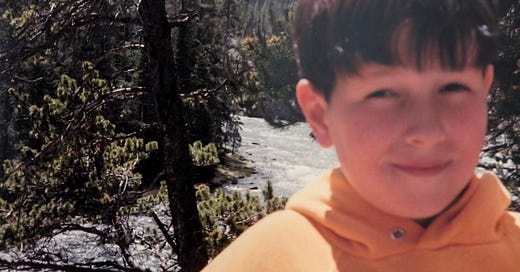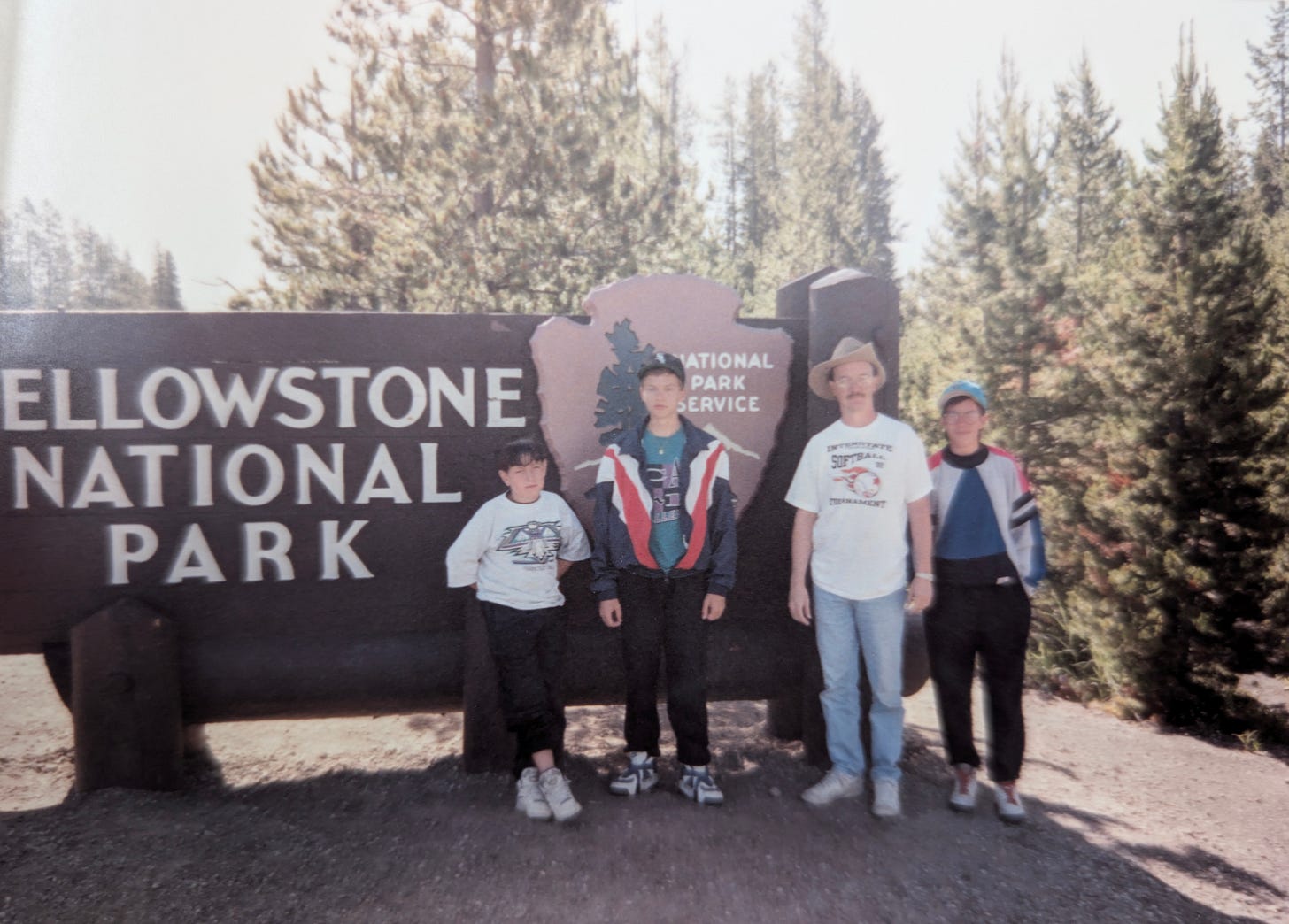Today I want to share a reflection I wrote a few years ago. Transparently, it’s a small excerpt of something I’m hoping to release as a sort of memoir later this year.
It also connects to something I recently shared—that I’m now offering “nature-based coaching.”
What’s nature-based coaching? It’s a blend of traditional coaching practices and nature-based connection and reflection. You can read more in the recent dispatch or on my website.
As we flow into July, hopefully you’ve been able to find time to get outdoors more than you normally do. Whether it’s hiking a park trail, hitting a beach, or simply going for a few more walks, the positive impacts of time outdoors are well established.
Noted psychologist Adam Grant just shared last week: “After just 2 minutes of viewing water outdoors, blood pressure and heart rate drop…Beaches are popular for a reason. Wider bodies of water bring more tranquility.”
And while I’d always recommend the real thing (going outside), it turns out simply watching immersive computer-generated virtual nature is like a cheat code for helping people improve cognition, feel more relaxed and refreshed, improve mood, feel less stress, and be more present and mindful.
Need a recommendation or call to action? Check out the Nature Pyramid, created by researcher Rachel Hopman, Ph.D.
Okay, on to an excerpt of writing about a childhood experience that not only shaped my connection with nature but bears similarity to what I’m exploring in my practice as a coach thirty years later.
I love to get away by myself to walk through the woods or along a river.
I feel rooted with a sense of smallness and connection in all the best ways when I spend time in nature.
When I was eleven, my family took an epic, two-week trip out west. In June of 1993, we packed everything up in our van that was fancy enough to have a separate cassette tape player in the back where my brothers and I switched between listening to music and playing games on the Nintendo Game Boy and Sega GameGear.
We crossed over the swollen Mississippi River, the furthest west I had ever been at that point, having grown up in central Indiana and only visited Chicago once or twice. “The Great Flood of 1993” ended up costing 15 billion dollars of damage, one of the most costly in U.S. history to that point. We made our way through Sioux City, Iowa, and wandered through the Badlands on our way to Mount Rushmore.
Seeing the scope and scale of nature, first with the largest river in the U.S. well into flood stage, then the barren Badlands. I was in awe of what I was seeing before we even got to Mount Rushmore. Seeing the scope and scale of the presidential faces up on a mountain was beyond anything my adolescent mind could comprehend. We drove past “Crazy Horse,” the still-unfinished monument to the Native American leader of the same name nearby, and my understanding of how big the world was continued to expand.
Yellowstone National Park was amazing. The hot springs, the spouting geysers, the waterfalls. We saw wild bison, an animal that shows up on the official seal of Indiana but had been driven out of the state around the same time my family was arriving in Kentucky prior to the Civil War. We saw a scorched forest from a wildfire in a previous season. And at the Yellowstone Inn, I fulfilled the challenge everyone in our family would be held accountable to: you have to try at least one new food you’ve never had before. A few of us had a bison burger for the first time. I had blueberry cheesecake ice cream. I never felt closer to those who had ventured west to explore new lands.
Yellowstone is also where I made official my commitment to loving the parks and nature.
The National Park system had a program called “Junior Rangers.” Focused on education and awareness, any kid could check in at a park station, get a program pamphlet from a ranger, then complete a series of activities and challenges to earn your official Yellowstone Junior Ranger badge.
Most of the activities were fairly straightforward—identify three types of trees, hike a trail, explore the Visitor Center. The most memorable and impactful activity though, was going on a park ranger-guided hike. I went on a group hike for kids with a ranger who took us about 20 minutes away from the trailhead. He pointed out a few different plant species and talked about the local ecosystem before asking us all to find a comfortable spot to sit or even lie down. He handed us each a pencil and a blank sheet of paper.
In his best Mr. Rogers voice, he talked about how we can learn about the park and the world around us, not just through our eyes, but with our ears as well. We were supposed to sit or lay with our eyes closed for five minutes, just listening to the world around us. I settled in and fought back a grin and chuckle because of how unusual it was for a group of 8 to 12-year-olds to sit in silence with closed eyes just listening to nature.
As we all opened our eyes and waited to get back on our feet, I remembered we had a pencil and paper in our laps. “Wait, what is this for?” I thought.
Our ranger then instructed us to draw a map, not of the landscape or the trail, but of the sounds we heard during our silent time. “Create a map of the world around you that you can hear, even if you can’t see it.” I created a swirling pattern of dashed lines to capture a flying bug, bee, or moth I heard flying by. I scribbled a bumpy and scattered cloud of short, faint lines to identify the rustling leaves I heard in the trees around us. I drew a series of tiny, intertwining waterfalls to demonstrate the bubbling creek that was just out of eyesight but recognizable when I slowed down to pay attention.
This idea of sitting to listen to nature (rather than just conquering it on a hike or capturing it in a photograph) was entirely new to me and only strengthened my admiration for nature. I doubt I had the words for it then, but now I recognize that feeling as a sense of awe and connection to a larger story, the story of the sustained natural world all around me that doesn’t need me to do anything for it to keep going on just like it has long before me and will long after me.
I tallied up all of my achievements and tasks before leaving the park. We stopped at the Visitor Center one last time and I presented my brochure to demonstrate my worthiness of the title “Junior Ranger.” The ranger behind the desk fumbled in a drawer and produced a small, two-inch woven badge and handed it to me. This felt like a lifetime achievement award, like a rite of passage and I couldn’t wait to earn another one.
To Check Out
Currently Reading:
The Heartbeat of Trees: Embracing Our Ancient Bond with Forests and Nature by Peter Wohlleben
I compiled a list of 15 books on nature and related things I would recommend.
Natural history, poetry, memoirs, nature-logues, fiction, and more. See the list and find your next summer read.
Complete the State Park Hiking Challenges / Visit Indiana (article)
I’ve been to 19 of the 24 Indiana State Parks. I will have to revisit a few to try out some of these challenges, chief among them being the Chain O’ Lakes “9 Lakes Challenge.” It’s my favorite Indiana State Park!
Seeing Our Ecological Crisis as a Spiritual Crisis / Center for Action and Contemplation (article)
“What if today’s ecological crisis was actually a spiritual crisis? Theresa Martella, former U.S. Environmental Protection Agency (EPA) Scientist and Living School sendee reflects on her own changing relationship to Nature as she expands her awareness of contemplative spirituality and practice.”
Hitler’s Olympics Part 1: The Blue-Eyed Tornado / Revisionist History (podcast)
The latest mini-series from Malcolm Gladwell is an eight-part look at the 1936 Olympics in Berlin, Germany—just as the world was about to enter World War II.
Race / (movie)
Along with the previous podcast recommendation, our house is fully gearing up for the Olympics. This 2016 movie about Jesse Owens is also set at the 1936 Berlin Olympics. A necessary reminder that some of our greatest athletes not only broke records but endured hate and injustice every step of the way.
Discover Natural Wonders with Lulu Miller / Via Podcast (podcast)
Lulu Miller is the cohost of my favorite podcast, Radiolab. Here’s she’s the guest! “On the latest episode of the Via Podcast, hosts Michelle Donati and Mitti Hicks explore a few of the incredible natural wonders located throughout the West—a dogsled excursion to view the northern lights in remote Alaska is just the tip of the awe-inspiring iceberg.”
This dispatch was written to music, including the 2021 Stephen Day song, On Top of the World.








